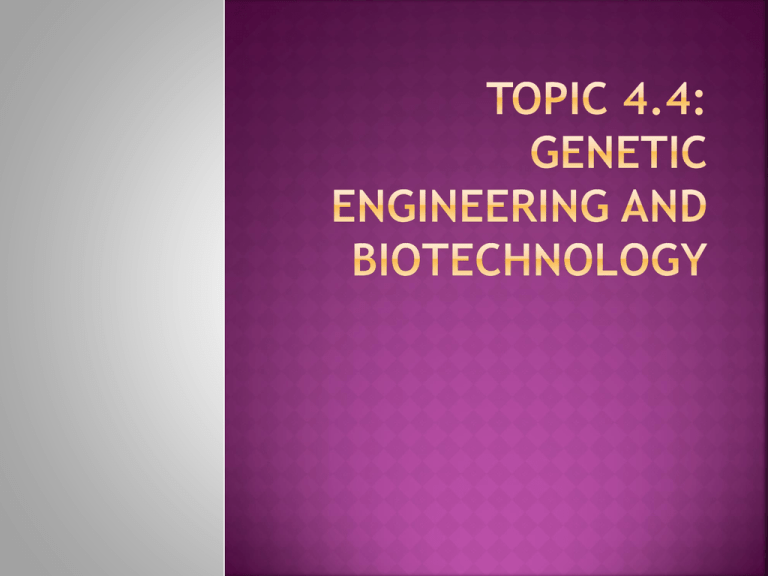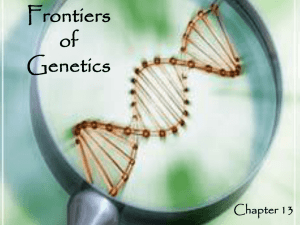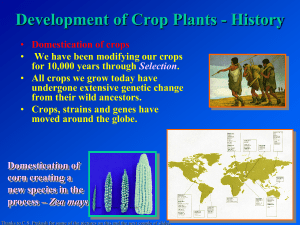Topic 4.4 genetic engineering and biotechnology (10
advertisement

4.4.1 Outline the use of polymerase chain reactions (PCR) to copy and amplify minute quantities of DNA 4.4.2 State that, in gel electrophoresis, fragments of DNA move in an electric field and are separated according to their size 4.4.3 State that gel electrophoresis of DNA is used in DNA profiling 4.4.4 Describe the application of DNA profiling to determine paternity and also in forensic investigations 4.4.5 Analyze DNA profiles to draw conclusions about paternity or forensic investigations 4.4.6 Outline three outcomes of the sequencing of the complete human genome 4.4.7 State that, when genes are transferred between species, the amino acid sequence of polypeptides translated from them is unchanged because the genetic code is universal 4.4.8 Outline a basic technique used for gene transfer involving plasmids, a hose cell (bacterium, yeast, or other cell), restriction enzymes (endonucleases) and DNA ligase 4.4.9 State two examples of the current uses of genetically modified crops or animals 4.4.10 Discuss the potential benefits and possible harmful effects of one example of genetic modification 4.4.11 Define clone 4.4.12 Outline a technique for cloning using differentiated animal cells 4.4.13 Discuss the ethical issues of therapeutic cloning in humans DNA is at the very core of what gives animals and plants their uniqueness New discoveries in genetic techniques include: Copying DNA (PCR) DNA revealing owner’s id (DNA Profiling) Mapping DNA (Human Genome Project) Cutting and pasting genes (gene transfer) Cloning cells and animals These new techniques offer new hope for: Treatment and vaccines Creating new plants Free or convicting people PCR is a laboratory technique which takes very small quantity of DNA and copies all the nucleic acids in it to make millions of copies of the DNA Solves a very simple problem-not enough DNA to analyze http://www.dnalc.org/resources/animations/pcr .html http://learn.genetics.utah.edu/content/labs/pc r/ This laboratory technique is used to separate fragments of DNA in an effort to identify its origin Enzymes are used to chop up the long filament of DNA into varying sized fragments DNA fragments are placed into small wells (holes) in the gel which are aligned along one end The gel is exposed to an electric current (positive on one side and negative on the other) The biggest , heaviest, and least charged particles do not move easily through the gel Smallest, least massive and most charged particles pass through the gel to the other side with little difficulty In effect is that the the end The fragments leave a banded pattern of DNA http://learn.genetics.utah.edu/content/labs /gel/ https://www.msu.edu/~russellr/portfolio/el ectrophoresis/electrophoresis.html The process of matching an unknown sample of DNA with a known sample to see if they correspond is call DNA profiling AKA DNA fingerprinting If, after separation by gel electrophoresis, the: Pattern of bands formed by two samples of DNA fragments are identical, it means that both most certainly came from the same individual Patterns are similar, it means that the two individuals are most probably related Applications of DNA profiling Paternity suits Match DNA to suspect Determine how closely related species are to each other Determine evolution Look at page 102 1990-started an international cooperative venture-Human Genome Project Goal: sequence the complete human genome 2003-annouced they succeeded the project Scientist are working on deciphering which sequences represent genes and which do what With genome libraries of genetic diseases, doctors can find out exactly where to look if they think one of their patients might possess a disease-carrying allele Other Produce new medications, Steps: Advantages: Find beneficial molecules which are produced naturally in healthy people Find out which gene controls the synthesis of a desirable molecule Copy that gene and use it as instructions to synthesize the molecule in a laboratory Distribute the beneficial molecule as a new treatment By comparing the genetic makeup of populations around the world, countless details could be revealed about ancestries and how humans migrated and mixed their genes with other populations over time The technique of taking a gene out of one organism and placing it in another organism is a genetic engineering procedure called gene transfer It is possible to transfer any species genes into another species makeup Example: proteins used by fish to resist the icy temperature of arctic waters are now produced by the modified tomatoes to make them more resistant to cold Example: corn, genetically engineered to produce toxins that kill the bugs which attack it (take protein from Bacillus thuringiensis) The scissors used for cutting base sequences are called restriction enzymes Restriction enzymes called endonucleases find and recognize a specific sequence of base pairs along the DNA molecule (4 or 6 sets of base pairs) The endonucleases cut the DNA at the specific points If both the beginning and the end of a gene are cut, the gene is released and can be removed from the donor organisms For pasting genes, the enzyme used is called DNA Ligase It recognizes the parts of the base sequences that are supposed to be clicked together, called sticky ends, and attach them http://www.dnalc.org/resources/animations /restriction.html This is more complex because a host cell is needed in addition to the cutting and pasting enzymes. (most common- Escherichia coli) Some DNA is found in structures called plasmids Plasmids are small circles of extra copies of DNA floating around inside the cell’s cytoplasm To copy a gene, it must be glued into a plasmid Plasmid is removed from the host cell and cut open using a restriction endonucleases To copy a gene, it must be glued into a plasmid Plasmid is removed from the host cell and cut open using a restriction endonucleases The gene to be copied is placed inside the open plasmid Process called gene splicing The plasmid is now called a recombinant plasmid and can be used as a vector, a tool for introducing a new gene into an organism’s genetic makeup In the final step needed for copying (or cloning) the gene. The vector is placed inside the host bacterium and he bacterium is given its ideal conditions to grow and proliferate. Done by putting the bacterium into a vat of nutritious liquid kept at a warm temperature Example: Used to make insulin Is one that has had an artificial genetic change using the techniques of genetic engineering One of the main reasons is to be more competitive in food production Transgenic Simplest kind of GM food is one in which an undesirable gene is removed In some cases, another more desirable gene is put in its place. First plants Example of GM Food 1994-Flavr Savr tomato-genetically modified to delay the ripening and rotting process Another tomato-able to grow in high salinity soil Rice-engineered to produce beta carotene Transgenic animals Haemophilia-Factor IX Using transgenic sheep Genetic engineering raising many social or ethical questions Benefits, promises, and hopes for the future GM crops will help farmers by improving food production GM crops which produce their own pest-control substances will be beneficial to the environment because fewer chemical pesticides will be needed Using GMOs to produce rare proteins for medicines or vaccines could be, in a long run, less costly and produce less pollution than synthesizing such proteins in laboratories Farmers can be more in control of what crops or livestock they produce (selective breeding) The multinational companies who make GM plants claim that they will enable farmers in developing nations to help reduce hunger by using pest-resistant crops or GM plants which require less water No one knows the long-term effects of GMO’s in the wild There is a danger that the genes could cross species Bt-crops which produces toxins to kill insects could be harmful to humans. The risks of allergies (may be allergic to one but not another) Critics are worried that large portions of the human food supply will be the property of a small number of corporations High tech solutions are not necessarily better than simpler solutions A proliferation of genetically modified organisms may lead to a decrease in biodiversity Clones and cloning The definition of a clone is a group of genetically identical organisms or a group of cells artificially derived form a single parent In either case, the resulting cells or organisms were made using laboratory techniques In farming, clones have been made for decades for regenerating plant material or by allowing an in-vitro fertilized egg or divide to make copies of itself 1996, a sheep by name of Dolly was born First clone whose genetic material did not originate from an egg cell This type of cloning is called reproductive cloning because it makes an entire individual Steps to create Dolly First the original donor sheep to be cloned, a somatic cell from the udder was collected and cultured. The nucleus was removed from a cultured cell An unfertilized egg was collected from another sheep and its nucleus was removed Using a zap of electrical current, the egg cell and the nucleus form the cultured somatic cell were fused together The new cell developed in vitro in a similar way to a zygote and started to form an embryo The embryo was placed in a womb of a surrogate mother sheep Dolly was born, and was presented to the world as a clone of the original donor sheep Cloning Therapeutic cloning-simply to make copies of cells using undifferentiated cells Aim is to develop cells which have not yet gone through the process of differentiation Since the first technique in this area involved using embryos, the cells are referred to as embryonic stem cells (stem cell research) Since therapeutic cloning starts with the production of human embryos, it raises fundamental issues of right and wrong Is it ethically acceptable to generate a new human embryo for the sole purpose of medical research Major breakthroughs (current research): Growing skin to repair a serious burn Growing new heart muscle to repair an ailing heart Growing new kidney tissue to rebuild a failing kidney Most researchers and medical professionals are against the idea of reproductive cloning in humans







